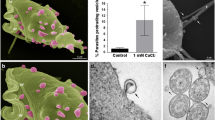Abstract.
The in vitro hemolytic activity of Trichomonas vaginalis has been previously demonstrated, but the mechanisms involved remain to be elucidated. In this work we used scanning electron microscopy to investigate the contact dependency of the hemolytic phenomenon caused by the parasites . The erythrocytes adhered to the parasites' surface and were phagocytosed. These observations suggest that the contact between T. vaginalis and erythrocytes may be an important mechanism in the injury caused to the erythrocytes. The hemolytic activity of T. vaginalis may be an efficient means of obtaining nutrients for the parasite and allow the investigation of the mechanism used by T.vaginalis to damage cellular membranes.
Similar content being viewed by others

Author information
Authors and Affiliations
Additional information
Electronic Publication
Rights and permissions
About this article
Cite this article
Rosset, I., Tasca, T., Tessele, P.M. et al. Scanning electron microscopy in the investigation of the in vitro hemolytic activity of Trichomonas vaginalis . Parasitol Res 88, 356–359 (2002). https://doi.org/10.1007/s00436-001-0555-6
Received:
Accepted:
Published:
Issue Date:
DOI: https://doi.org/10.1007/s00436-001-0555-6



